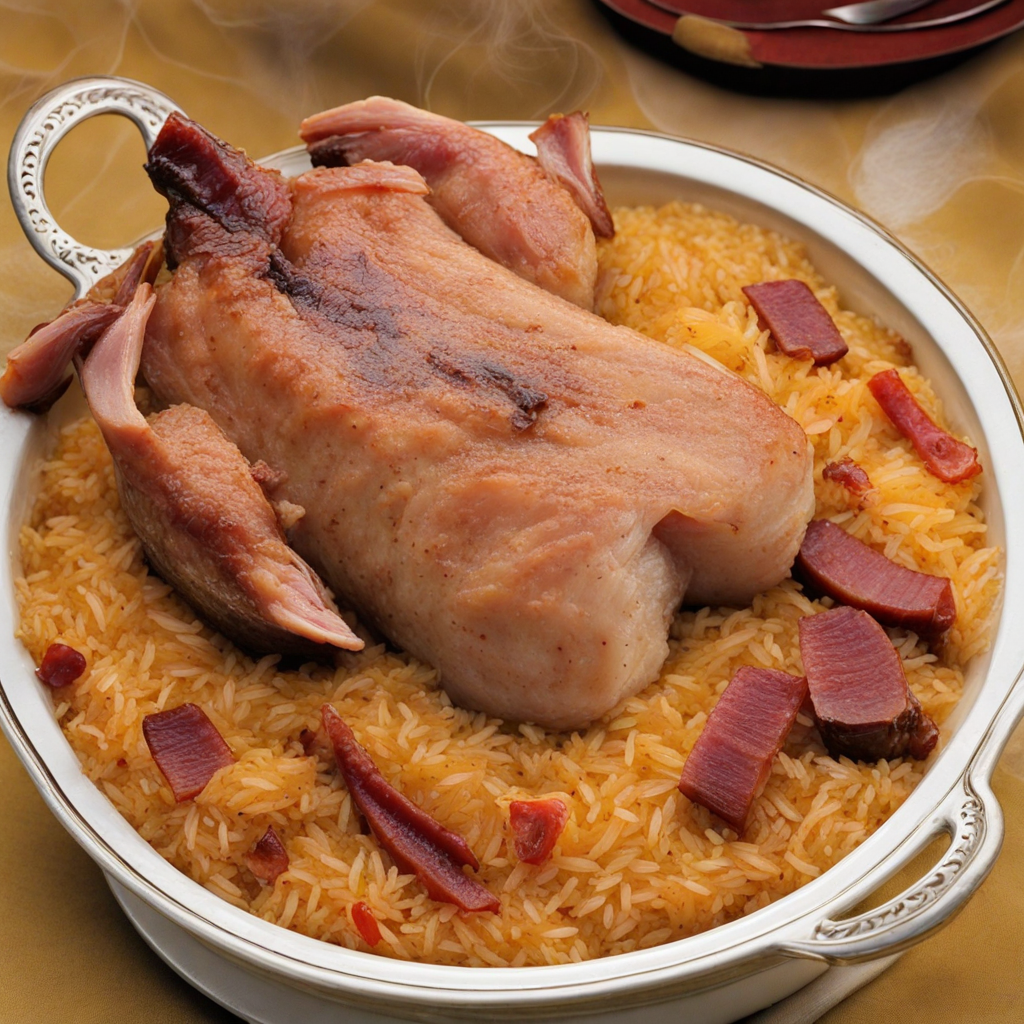Arroz de Pato
Arroz de Pato, or Duck Rice, is a traditional Portuguese dish that beautifully marries the rich flavors of duck with the comforting essence of rice. This dish features tender, slow-cooked duck, which is often roasted or braised until it reaches a melt-in-your-mouth texture. The meat is then shredded and mixed with perfectly cooked rice, allowing the grains to soak up the luscious duck juices, creating a dish that is both hearty and satisfying. The addition of aromatic herbs, such as bay leaves and parsley, elevates the flavor profile, making each bite a delightful experience. What sets Arroz de Pato apart is its unique preparation method. The rice is typically cooked in the flavorful broth created from the duck, often enriched with onions, garlic, and sometimes tomatoes, which add depth and complexity to the dish. As the rice absorbs the savory broth, it becomes infused with the essence of the duck, resulting in a wonderfully fragrant and colorful presentation. The dish is often topped with crispy slices of chorizo or a sprinkle of paprika, adding a touch of smokiness that complements the richness of the duck. Arroz de Pato is not just a meal; it's a celebration of Portuguese culinary heritage. Often served for special occasions or family gatherings, it embodies the warmth and heartiness characteristic of Portuguese cuisine. The combination of textures—from the tender duck to the fluffy rice and the crispy chorizo—creates a delightful contrast that is sure to please any palate. With every forkful, you embark on a journey through the rustic landscapes of Portugal, making Arroz de Pato a must-try for anyone looking to explore new and exciting flavors.
How It Became This Dish
Arroz de Pato: A Culinary Journey Through Portugal’s Rich Tapestry Arroz de Pato, or Duck Rice, is a traditional Portuguese dish that encapsulates the culinary heritage of Portugal, reflecting its history, culture, and the evolution of its gastronomy. This dish, characterized by its rich flavors and hearty ingredients, has become synonymous with comfort and familial gatherings, serving as a testament to the country's ability to blend simplicity with sophistication in its cuisine. Origins: A Historical Perspective The origins of Arroz de Pato can be traced back to the rural landscapes of Portugal, where agriculture and livestock farming have long been integral to the way of life. The dish is believed to have emerged in the 19th century, particularly in the Alentejo and Ribatejo regions, where duck farming was prevalent. Ducks were an accessible source of protein for the peasant communities, and rice, introduced to the Iberian Peninsula by the Moors, became a staple carbohydrate. The preparation of Arroz de Pato varies from region to region, reflecting local ingredients and culinary traditions. The use of rice in the dish showcases the Moorish influence, as rice cultivation flourished in the regions where they settled, especially in the fertile river valleys. The marriage of duck and rice is not only practical but also embodies the resourceful spirit of Portuguese cuisine, where nothing goes to waste. Cultural Significance Arroz de Pato holds a special place in Portuguese culture. It is often prepared for family gatherings, festive occasions, and Sunday meals. The dish is not merely food; it is a means of bringing people together, evoking nostalgia for shared experiences around the dining table. In many households, recipes are passed down through generations, each family adding its personal touch, contributing to a rich tapestry of variations. Moreover, the dish symbolizes the Portuguese connection to the land and the seasons. Ducks are often associated with autumn and winter, coinciding with the hunting seasons. As such, Arroz de Pato is frequently enjoyed during these cooler months, making it a seasonal comfort food. Its robust flavors and satisfying texture resonate with the heartiness of Portuguese cooking, making it a staple in both rural and urban settings. Development Over Time As Portuguese cuisine evolved, so did Arroz de Pato. In the 20th century, with the rise of culinary tourism, the dish gained recognition beyond the borders of Portugal. It began to appear on restaurant menus, often elevated with gourmet twists. Chefs started experimenting with ingredients, incorporating elements such as chorizo, saffron, or even local herbs to enhance the dish's flavor profile while maintaining its traditional essence. In contemporary times, Arroz de Pato has found its way into the hearts of food enthusiasts worldwide. It is celebrated in Portuguese restaurants globally, from Lisbon to London and beyond. Here, it serves as a culinary ambassador of Portuguese culture, inviting diners to experience the warmth and hospitality that Portuguese cuisine embodies. Traditional Preparation The traditional preparation of Arroz de Pato involves several key steps that highlight the dish's complexity and depth of flavor. The first step is to cook the duck, often seasoned simply with salt, pepper, and bay leaves. The duck is then simmered until tender, and the resulting broth is reserved for cooking the rice. This broth is where the dish's flavor truly develops, imbuing the rice with the richness of the duck. Once the duck is cooked, it is typically shredded and mixed with sautéed onions, garlic, and sometimes tomatoes, creating a fragrant base. The rice is then added, along with the reserved broth, and cooked until the grains absorb the flavors. The dish is often finished in the oven, topped with slices of duck and sometimes a crispy layer of breadcrumbs or cheese, creating a delightful contrast of textures. Regional Variations Portugal's diverse geography has given rise to numerous regional variations of Arroz de Pato. In the Alentejo region, for example, the dish is often enriched with local spices and served with a side of greens. In contrast, coastal areas may incorporate seafood elements, reflecting the maritime influence on Portuguese cuisine. Furthermore, some versions include the addition of olives or nuts, showcasing the local produce and flavors. The dish has even inspired modern interpretations, where chefs experiment with cooking techniques and presentation styles, such as deconstructing the dish or infusing it with international flavors. Yet, despite these innovations, the heart of Arroz de Pato remains the same: a celebration of duck and rice that brings people together. Conclusion: A Dish of Heritage and Community Arroz de Pato is more than just a dish; it is a narrative woven into the fabric of Portuguese culture. It tells the story of a nation that cherishes its agricultural roots, where every ingredient is a reflection of the land and its people. The dish embodies the spirit of sharing and community, inviting everyone to partake in its warmth. As food enthusiasts and home cooks continue to explore and reinterpret Arroz de Pato, they not only preserve a culinary tradition but also contribute to its ongoing evolution. This dish, with its deep historical roots and cultural significance, stands as a testament to Portugal’s rich gastronomic heritage, ensuring that it remains a beloved staple for generations to come. Whether enjoyed in a cozy home or a bustling restaurant, Arroz de Pato continues to evoke a sense of belonging, a celebration of life, and the timeless joy of sharing a meal.
You may like
Discover local flavors from Portugal







